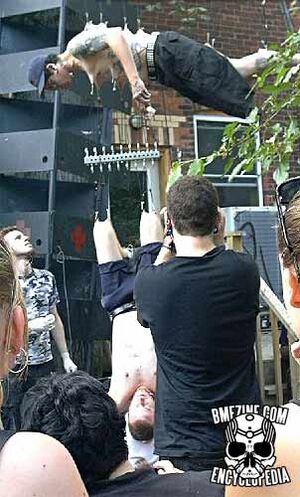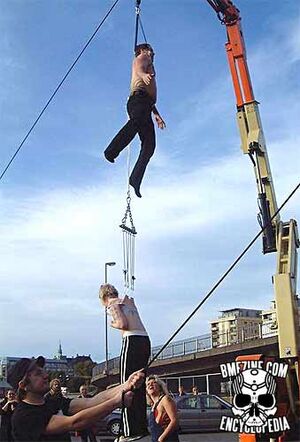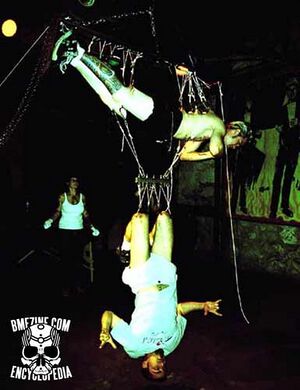|
|
| Line 1: |
Line 1: |
| [[File:Tamils.jpg|thumb|Group rituals at the '''Sivananda Ashram'''][1]]
| | '''Tandem Suspension''' is a [[Category:Suspensions|suspension]] in which one person is suspended by hooks from another person. This suspension was originally named by (and first done in the West by) [[Allen Falkner]], who first did it with Oliver from [[TSD]]. That is, one person is suspended normally, and then a second set of hooks is attached below them. The ropes from these hooks then suspend the second person (ie. it's not two people suspending side-by-side). |
| [[File:Tamils2.jpg|thumb|'''Thaipusam''' hook-swinger in Ceyon in the 1930’s (Is this Superman?)[1]]] | |
|
| |
|
| The '''Savite''' Hindus are a religious sect of [[Hinduism]] also found in western Malaysia, northern Sri Lanka, and in '''Tamil Nadu''', a state in the southern tip of [[India]]. The group is known for their ritualistic piercing and suspensions.
| | {| class="wikitable" style="text-align: center;" |
| | |- |
| | |[[File:Tandem_Suspension-1.jpg|thumb|Tandem Suspension]] |
| | |[[File:Tandem_Suspension-2.jpg|thumb|Tandem Suspension]] |
| | |[[File:Tandem_Suspension-3.jpg|thumb|Tandem Suspension]] |
| | |} |
|
| |
|
| [[Fakir Musafar]] writes in his article series for BME: | | Many configurations are possible of course, and [[Blood Bowl]] can be used to stop blood from running between the ropes from one suspendee to the next. |
|
| |
|
| :''Two major Hindu Festivals are especially focused on body piercing rituals: '''Thaipusam''' in January/February and '''Chidi Mari''' in May/June. Both festivals are celebrated primarily by Savite Hindus (devotees of Lord Siva, Muruga, Murugan, Subramanya, the Great Mother Mari and Kali). Other Hindus, like the followers of Vishnu or Krishna, do not usually practice body rituals or employ body piercing in their religious practice. In fact, they often hold these rites in contempt. The Savites are mostly the dark-skinned Tamil people of Southern India (Tamil Nadu) and direct descendents of the original indigenous peoples of India. Their Tamil language used in the chants of their “Pujas” (worship) is the spoken equivalent of the ancient written language of Sanskrit. Historically, the Tamil peoples have been persecuted for hundreds of years. First by the light-skinned Northern Indians, descendents of Aryan invaders, then by the British colonialists who hauled them off as virtual slaves to work on tea plantations in Ceylon (now Sri Lanka) and other parts of the British Empire. Wherever they’ve been taken by force, the Tamil people have been remarkably successful in preserving their culture and spiritual practices...
| | == See Also == |
| | * [[Spinning Beam]] |
|
| |
|
| :As public festivals, both the Thaipusam and Chidi Mari have been effectively outlawed in India and Sri Lanka. Too barbaric. But in other parts of Southeast Asia, especially Malaysia and Thailand, these “torture festivals” still flourish. The Chidi Mari Festival is devoted to worship of the “Great Mother” (Mari) and other female deities like Kali. Devotees are often pierced by two hooks in the back, suspended on the end of a long pole and rotated high in the air. Others are pierced with multiple hooks and suspended horizontally for long periods of time (two to six hours). All this done to attain a “State of Grace” (ecstatic trance) in which the Great Mother possesses their bodies and bestows enlightenment and blessings on them and their families.
| | == Related Risks == |
| | | * [[Bloodborne Pathogens]] |
| :Thaipusam is a piercing festival to Lord Siva and especially the Hindu dieties who are “Stars in His Crown”: Muruga, Murugan, Subramanya, Skanda, Ganapati. Devotees vow to bear a gift to the deity (archtype) under physical hardship. This is considered the purest of gifts — the offering of one’s own body pierced with spears, skewers or hooks as it delivers the gift. This is “Worship Through the Body” and such a gift is especially accepted and blessed by such deities (archetypes) as Murugan, Lord of Piercing and patron Saint of the Tamils. When I witnessed the Thaipusam in Penang Malaysia in 1995, I felt the reality of the sacrificial energy released. It was overpowering, intoxicating, sweet, and very similar to the energy that I have experienced at many of the body suspension and hook pulling rituals I have facilitated or witnessed in recent years.[1]''
| | * [[Rice Crispies]] |
| | | * [[Torn Suspension Hook]] |
| ==Sources== | |
| * [http://www.bmezine.com/news/fakir/20031115.html [1]] [[Fakir Musafar]]'s article ''Suspensions & Tensions I: Yesterday'' on [http://www.bmezine.com/news/bmenews.html BME News] | |
Tandem Suspension is a in which one person is suspended by hooks from another person. This suspension was originally named by (and first done in the West by) Allen Falkner, who first did it with Oliver from TSD. That is, one person is suspended normally, and then a second set of hooks is attached below them. The ropes from these hooks then suspend the second person (ie. it's not two people suspending side-by-side).
Many configurations are possible of course, and Blood Bowl can be used to stop blood from running between the ropes from one suspendee to the next.
See Also
Related Risks


